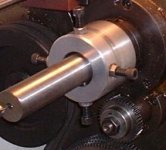P
pdhntr
Guest
Or...you could just order some brass tipped allen head cap screws from MSC. I ordered the 5/16-18 ones and they work great.
As for fitting the spider, try this. CHuck up a piece of stock large enough to mimic the OD on the spindle (back side) of your lathe. Measure the OD and TPI and go for it. Start the thread and with your dial calipers, measure the pitch diameter of the spindle. This will not be a true Pitch diameter but it will be close. Write it down and keep threading your test piece. When you get it to the pitch diameter of the spindle you are done. Take it out and when making your spider, use the test piece to check the fit on the inside threads. It works, believe me. And you don't sdneed to take it out of the lathe to check the fit or pick up the thread again.
Jim
Hi Jim,
I have a piece of stock that I cleaned up to do this with.
I defintely believe it works if YOU do it, but the jury is still out with respect to my work.
Thanks for all the help.
Jim


